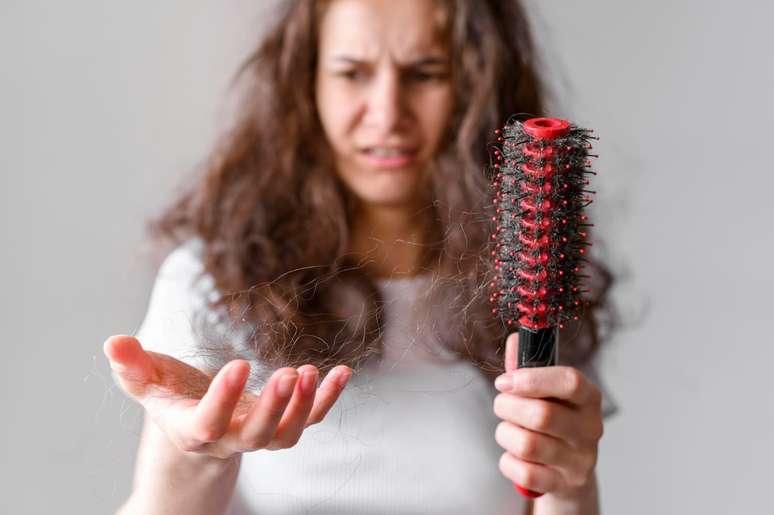Some good habits can save your hair, according to science
Summary
Baldness is a genetic condition that can be prevented with measures such as quality sleep, a balanced diet, avoiding stress and scalp care.
Baldness is a genetic condition and although it cannot be completely prevented, there are some measures that can make the follicles more resistant to the aggression received by the balding hormone. One of the first phases noticed by patients is to notice increasingly thin hair.
“In women, at the very beginning of baldness, the first impression is that the hair has lost weight, volume, and is no longer growing, until the progressive thinning reaches the point of exposing or showing the whiteness of the scalp. Fine, thin hair is most common on the top of the head, in the midline of the hair, but can also affect the crown and appears diffusely, without causing bright spots or well-defined circular defects. There are varying degrees of alopecia and the exposure of the scalp is determined by the severity of the alopecia, but women rarely have a smooth and shiny bald head like that of men. Male thinning begins with the recession of the hairline in the frontal region (the famous “recessions”) and the formation of a bald spot on the top of the scalp. Over time, the bald areas can expand and merge, resulting in a completely bare area, leaving the scalp smooth and shiny. The back of the neck is spared, since in this area there are no hormone receptors attached to the follicles and that is why in cases of hair and neck transplants we remove the follicles to be transported to the bald area,” explains Dr. Lilian Brasileiro, member of the Brazilian Society of Dermatology.
It provides some suggestions on what can be done to prevent the problem:
• Quality sleep: “Go to sleep early, preferably before 10:30 p.m. This measure is important so that deep sleep cycles are sufficient for the entire body to carry out its regenerative processes, including the hair follicle,” says Lilian Brasileiro.
• hair food: The term “hair food” is often used by the nutraceutical industry, promising to provide quality and nourishment to the hair. “The great truth is that nothing replaces a balanced diet, rich in vitamins and minerals essential for healthy hair, such as vitamin A, vitamin D, vitamin E, iron and zinc. Foods such as fruits, vegetables, fish, nuts and seeds are beneficial for your hair. Only after optimizing the diet should you resort to supplements,” adds the doctor.
• Pay attention to the traction: “Avoid hairstyles that pull too hard on your hair every day, such as tight ponytails, tight braids, or buns. Excessive and constant pulling on your hair causes permanent scarring of the follicles, which prevents new hair from growing.
• Disinfection: Keeping your scalp clean and healthy is essential, according to the doctor, to avoid the accumulation of dirt, fungi and sebum. “The frequency of washing is dictated by the oil that your scalp produces, if, to keep your scalp clean, you have to wash them every day, so be it. Just avoid applying shampoo every day to the lengths and pay attention to hydration,” he explains.
• Avoid stress: According to Lilian, far from being a myth, it is already scientifically proven that the increase in cortisol that occurs during stress consumes a protein that anchors the hair follicle to its cavity, in addition to altering the phases of the hair cycle, anticipating the phase of falling out. “Practice stress management techniques, such as regular physical exercise, meditation, yoga or other relaxing activities,” she comments.
• Do not smoke: Smoking reduces blood circulation in the scalp, which means that oxygen and nutrients from food are not delivered to the follicles. “Not to mention the chronic microinflammation that promotes the oxidation of melanin production in the hair, increasing the amount of gray hair,” explains the doctor.
• Health care: “Take care of recurring infections such as: candidiasis, herpes, sinusitis, urinary tract infections. Your body is wise, it steals all the nourishment from the follicles while it is busy fighting your infection,” says the doctor.
Hair Loss Treatments
To take even better care of your scalp, it is ideal to consult a doctor as soon as you notice that your hair is falling out too much and some areas are more “empty”.
“From the moment the patient is diagnosed with chronic hair loss, the treatment usually lasts a lifetime and its purpose is to thicken the fine hair, prevent the still healthy strands from thinning and, above all, keep the follicles alive, since no treatment is able to create a hair follicle, not even an implant. So, in order for the diseased follicle to heal, we need treatments that inhibit the action of DHT, increase the anabolic phase of the follicle, to keep it functioning,” explains Lilian.
“The gold standard for hair loss treatments are 5-alpha-reductase inhibitors (represented by finasteride and dutasteride) which work by reducing the conversion of testosterone into dihydrotestosterone (DHT), hindering the supply and coupling of this hormone in the follicle, thus reducing the miniaturization of hair follicles, in addition to prolonging the hair growth cycle. This is expected to increase hair density and reduce hair loss,” explains the doctor.
Regenerative treatments, laser and scalp care through Keravive Hydrafacial are available in the office. “The great advantage of outpatient treatment is that it provides deep cleansing and exfoliation that the patient cannot get with regular washing at home. In addition to acting on dandruff, reducing itching, flaking and dryness, the procedure can also help treat hair loss and can stimulate the growth of follicles if they are at rest. It is worth remembering that a number of factors influence the success of the therapy, such as the type of alopecia and the individual response of the patient. But, in general, improving the health of the scalp, with greater nutritional support and an increase in the microcirculation process, can help treat different types of hair loss,” says the specialist.
Danilo S. Talarico, MD, professor and resident in Hair Surgery and Trichology, explains that treatments such as Megaderme Duo are important, a microneedling radiofrequency system that works to improve hair loss, ensure accelerated growth and thicken hair. And hair transplantation, according to the doctor, brings excellent results when combined with clinical treatment. The procedure consists of replacing the patient’s follicular units (the structure where the “root” of the hair is located), in the regions where miniaturization or atrophy of the hair has occurred due to baldness.
“With the FUE technique, the follicles are removed through several mini-incisions throughout the scalp of the donor area, where the follicles are already separated. It is a technique that can be performed by robot or manually. The transplant with this technique lasts from 8 to 12 hours and allows the patient to sleep, since it is performed under intravenous anesthetic sedation,” explains Danilo Talarico.
“Robotic technology helps the doctor to collect follicular units with precision and efficiency, but it still does not surpass the artistic work performed manually with technological extraction machines in the expert hands of an experienced doctor with instruments less than 0.8 millimeters in diameter,” concludes the doctor.
According to Danilo, surgery is an option for those who suffer from thinning hair and are already undergoing conservative treatment, but want to further restore hair density. “The postoperative period is very calm, painless and, generally, the patient returns to his routine after a few days, but it is recommended to avoid sun exposure and rubbing the transplanted area for a few days. It is normal for the transplanted hair to fall out in the month following the procedure. However, this process is perfectly normal and the hair grows back soon,” he concludes.
inspires transformation in the world of work, in business, in society. Compasso, a content and connection agency, is born.
Source: Terra
Ben Stock is a lifestyle journalist and author at Gossipify. He writes about topics such as health, wellness, travel, food and home decor. He provides practical advice and inspiration to improve well-being, keeps readers up to date with latest lifestyle news and trends, known for his engaging writing style, in-depth analysis and unique perspectives.




-qxia4sk19vfn.jpg)



